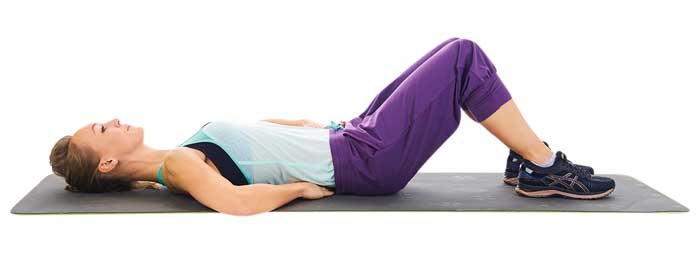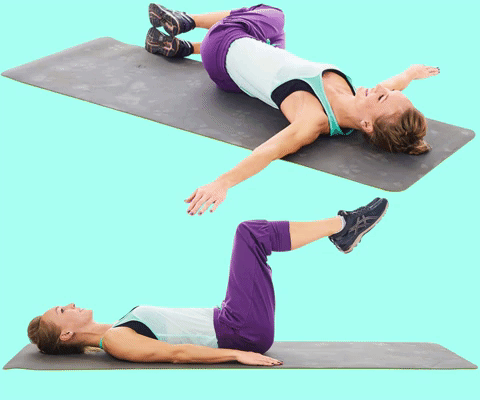Before starting your postnatal core training workout, you need to get clearance from your doctor; it’s important for your stomach muscles to have moved back to their normal position before you start this workout.
As a rule of thumb, start training after six weeks if you had a regular delivery, and 10 weeks if you had a C-section.
Sets and reps:
Start with two sets of eight to 10 repetitions and build up until you can do two sets of 15.
Single leg toe taps

Muscles: Deeper stomach muscles, stomach muscle (transversus abdominis, rectus abdominis)
Why do it?
This helps to strengthen the lower part of your stomach. It’s very important if you had a C-section.
Technique:
• Lie flat on your back and lift your legs up to a right angle.
• Keep your arms on the floor next to your body.
• Perform a pelvic tilt like in exercise one above.
• Slowly lower your right leg until your toes touch the floor.
• Lift your right leg up to the starting position and repeat with your left leg.
Watch points:
Ensure you use your core muscles; don’t just move your legs up and down.
Pelvic tilt

Muscles: Pelvic floor muscles
Why do it?
Activating the muscles of your pelvic floor forms the basis of your core strength and postnatal strength exercises.
Technique:
• Lie on your back, with your knees bent and your feet flat on the ground. You should have a normal arch in your back.
• Place the fingertips of one hand on your hip bone. The other hand sits at the small of your back.
• Push your lower back flat into the floor. You should have felt your hand move slightly up towards your ribcage. Check your control– you should feel the same amount of pressure on your hand at the small of your back.
• Arch your back off the floor.
Watch points:
Use these pelvic tilts to warm up your core muscles.
Superman

Muscles: Back muscles (erector spinae)
Why do it?
Holding baby, carrying car seats and breastfeeding can take their toll on your back. By strengthening your back muscles, you’ll be able to cope with the added weight as your baby gets heavier.
Technique:
• Lie on your stomach with your arms extended out in front of you.
• Rest your forehead on the floor.
• Lift your right leg and left arm off the floor, then slowly lower with control.
• Repeat the move with your left leg and right arm and keep alternating.
Watch points:
Don’t lift your head up as you could strain your neck.
Crunches

Muscles: Stomach muscles (rectus abdominis)
Why do it?
Strengthening your stomach muscles will help you get your pre-pregnancy shape back.
Technique:
• Lie on your back on the floor with your knees bent and your feet flat on the floor.
• Place your hands next to your ears.
• Look up at the ceiling.
• As you lift your head and shoulders off the floor, make sure that you do a pelvic tilt, like in exercise one.
• Slowly lower with control – and remember to breathe.
Watch points:
Ensure that you don’t pull on your neck while you’re crunching upwards.
Kettlebell stomach lifts

Muscles: Deeper stomach muscles (transversus abdominis), PLUS neuromuscular activation (nerve communication between your brain and muscles)
Why do it?
Due to pregnancy changing the position of your stomach muscles, it’s important to activate the nerves supplying your stomach muscles, especially if you had a C-section.
Technique:
• Lie on your back on the floor.
• Place a kettlebell on your stomach and hold it in place with your hands.
• Pull your belly button in towards your spine and gently push down with your hands on the kettlebell.
• Make sure you’re not holding your breath.
• Push your stomach out and lift the kettlebell up.
• Keep your hips and shoulders as still as possible throughout.
Watch points:
Keep breathing normally while doing this exercise. The more you practise, the more movement and control you’ll get.
Side leg lifts

Muscles: Side muscles (obliques)
Why do it?
To work your core – and shape your butt. You may feel weak at first, but your muscles should soon get stronger.
Technique:
• Lie on your right side with your right arm supporting your head.
• Keep your left arm in front of your body to aid your balance.
• Lift both legs off the floor.
• Complete one set before changing sides.
Watch points:
If your hip bones dig into the floor, roll your hips slightly forward or backwards until you find a comfortable position.
Bridge

Bridge
Muscles: Back thigh muscles, bottom, core muscles (hamstrings, glutes, transversus abdominis)
Why do it?
During pregnancy, the hormone relaxin relaxes the ligaments and muscles around the pelvis. This exercise will help to strengthen your hips and lower back to prevent postnatal injuries.
Technique:
• Lie on your back on the floor with your knees bent and your feet flat on the ground.
• Do a pelvic tilt (see exercise one).
• Lift your bottom off the floor until you form a straight line between your knees, hips and shoulders.
• Squeeze your bottom and pull your belly button towards your spine.
• Lower your hips until they touch the floor, but don’t rest.
Watch points:
Make sure to keep your tummy pulled in – don’t let it bulge out.
Hip rolls

Muscles: Side muscles (obliques)
Why do it?
Strengthening these muscles will help you to get your waistline back.
Technique:
• Lie on the floor with your legs at a right angle.
• Take your arms sideways and place your palms flat on the floor.
• Slowly roll your legs over to the right side.
• Allow your knees to touch the floor, but try not to rest.
• Make sure your shoulders remain on the floor.
• Roll your legs back up to the starting position.
• Roll your legs over to the left.
• Alternate between the two sides.
Watch points:
If you find this exercise too hard, keep your feet on the floor until you’re strong enough to keep your legs at a right angle.
Words: Anne-Marie Lategan


